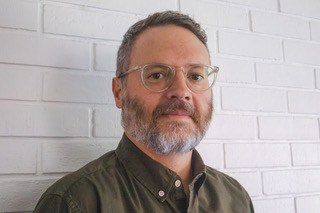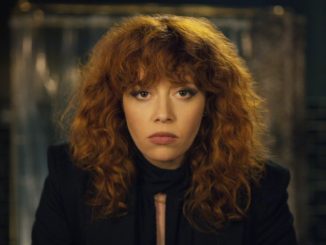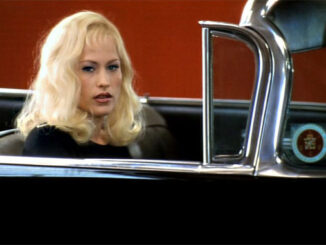
By Rob Feld
Evan Henke has always had that fascination with a certain art form. “Ever since I was a kid, I wanted to work in movies,” he said.
To pursue his dream, he attended the University of Texas at Austin, drawn by its strong film program and vibrant local film community. In his first film class, his professor asked 300 students: “Who wants to be a director?” Nearly every hand in the room shot up. “That was a humbling experience,” Henke recalled. Fortunately, he found his passion in editing. “I enjoyed putting the puzzle together on my own while working as part of a team to bring a story to life,” Henke explained, eventually finding himself volunteering to edit other people’s projects.
Mentorship played a crucial role in Henke’s growth as an editor. Early on, he worked as an assistant editor on three feature films with editor Ned Bastille and the then-assistant editor (now editor) Pamela March. “Pamela taught me how a cutting room operates from the ground up, while schooling me on the mechanics of the Avid,” Henke said. He valued this real-world knowledge, recognizing that film school couldn’t fully prepare him for the pressures and personalities of a cutting room. Henke also learned about the importance of interpersonal relationships from Bastille, who always treated people with respect even under stressful conditions. Another key influence was the late Sally Menke, who taught him the value of the director-editor relationship during their collaboration on “Inglourious Basterds.” “The bond she and Quentin Tarantino had, as true collaborators, is something I always look for,” Henke says. His experience with Michael Tronick further shaped his understanding of the editing craft and the dynamics between departments. “The way Michael commands a room was, and is, inspiring,” he recalled.
Henke’s elevation to editor came unexpectedly. While serving as the first assistant editor on “The Green Hornet,” he was called into Tronick’s office. “The studio was offering to bring on an additional editor,” Henke recalled. “I said, great. Who are you thinking about? To my surprise, he said, ‘You, Evan.’ He placed his trust in me and gave me the confidence to step out of my comfortable role as an assistant.” Since then, Henke has built a solid place for himself as a premier editor of comedy, working recently with Jerry Seinfeld on “Unfrosted,” released on Netflix earlier this year, where the type of close collaboration with collaborators he experienced throughout his career was pivotal.
CineMontage: Did you intend to build a career in comedy or did it find you?
Henke: When I first moved to Los Angeles in 2004, I started out as an assistant editor on some DVD bonus material projects. It was a typical first job—long hours, little recognition, and seemingly a long, long way from my dream career. But I was working and learning, and starting to meet good people like editor Paul Covington. My next priority was to work on a union, narrative film. As it happened, my first few projects as an assistant editor turned out to be comedies. In this business, the relationships we build on projects are what lead to new projects. So, working with people on comedies led to more work on comedies. Hooking up with Seth Rogen and Evan Goldberg on “The Green Hornet” really put me on my path. Their network of friends and creative contemporaries is so extensive, I began working with some of their collaborators, from Danny McBride, Jody Hill, and David Gordon Green on “Eastbound and Down,” to Andrew Cohen on “The House,” to Sacha Baron Cohen on “The Brothers Grimsby,” to Jonathan Levine on “Long Shot.” Pretty soon, I was considered a comedy guy.

CineMontage: What kind of footage do you want as a comedy editor? What have you found constrained your options vs. gave you freedom to make the humor play?
Henke: I don’t think you can ever have too much footage when it comes to a comedy. It’s better to have more than you need than to be missing something. In terms of content, I’m always looking for multiple options for the scripted material. Oftentimes, actors go straight to alts and improv and, although funny, it’s sometimes difficult to weave that into the story. If you have a solid version of the script, which hopefully works on the page, then the improv can often elevate a scene. On the flip side, you may have lots of spontaneous, funny material, but if it has nothing to do with the story, it’s a risk jamming it in. There has to be some discipline when cutting for comedy. The story and character still have to be front and center. Deciding when people laugh can be just as exciting as what they are laughing at.
CineMontage: Can you say more about working with improvised footage?
Henke: I’m also looking for alts and improv that carry through coverage. So many times, I’ll find a great bit of improv, but it only exists in close coverage, after other characters’ coverage has been completed. So, I don’t have reactions for responses. When I worked with Kyle Newacheck on “Game Over, Man!” I was so impressed with how Anders Holm, Adam Devine, and Blake Anderson carried their improv between setups. They’d been performing together on “Workaholics” for years and they had this incredible ability to cover alts and improv in almost all the coverage. They often stopped between takes to discuss what improv had or hadn’t been covered. To make great improv comedy work, you also need a wealth of reaction shots. If you have funny improv in only one actor’s coverage, you need something to cut to on the other side to make it flow. There are some actors that never stop reacting with their eyes and they can be your “get out of jail” cards. In terms of framing, clean singles can be extremely helpful. Although not always as elegant as dirty overs, they allow you to cut without worrying about what other actors are doing in the frame. Ideally, your characters are interacting with each other in the same frame, but clean singles allow you freedom to extend moments, and effectively utilize improv.
CineMontage: How do you like to collaborate with your director?
Henke: Every project is different, as is every director. Getting on the same page as early in the process as possible is key to a smooth post. That’s why first meetings with directors are so important. Of course, they’re interviewing you to see if they think you’re someone they’d like to work with. But those first opportunities to meet can inform how you’ll work for the next year or so of your life. You’re hopefully learning what the director wants creatively as well as what they need in a collaborator. Some directors want to see cut scenes during production and others want to wait until it’s all assembled to see anything. Some like to talk every day, others once a week. As editors, we learn to adapt.
CineMontage: What was a memorable collaboration?
Henke: I had an especially good experience with director Clay Tarver on “Vacation Friends.” We had an immediate connection over the script and what type of film it could be. He kept calling it a “sneaky” movie in that the comedy sort of sneaks up on you. It’s a simple story – two couples meet on vacation, and one couple, without permission, follows the other into their real lives. I loved the math of that. He leaned on me during production with questions about coverage and performance. That type of collaboration is I think what every editor looks for. How often do we look at footage and think, “If they would have just asked, we may not have a problem.” So many times, editors are painted into corners because of the limitations of the footage. Obviously, it’s our job to get out of those jams, but if we’re included early in the process, we can avoid some of those traps.
CineMontage: What was the experience of working with Jerry Seinfeld as a director – I’m wondering if his sensibility as a standup gave a different flavor to his approach to footage, timing, etc.
Henke: Working with Jerry on “Unfrosted” was, for me, a culmination of a 20-year dream come true. Like so many of us, I grew up watching “Seinfeld.” I felt like I already had a shorthand with his style of comedy. And even though the film is a lot different from the show, his comedic sensibilities remained the same. When we met for the first time, we discussed the tone of the movie. He wanted it to feel like an old ensemble comedy, like “It’s a Mad, Mad, Mad, Mad World” or “A Guide for the Married Man.” The jokes were cut tight and there was a definite pace to them. Jerry is a standup comedian, first and foremost. He spends years honing his jokes on stage, working to perfect timing and delivery. It was very similar on set. He had a clear vision of where he wanted the comedy to go but he also let his actors explore. Jerry liked to go through every delivery to make sure the timing was right. ScriptSync really helped with that. We could quickly pop between line reads and he’d narrow them down to his top three, and then we’d have a bake off. As a standup comedian, Jerry relies heavily on his audience. He often said, “The audience writes the jokes,” because based on their reactions, he’d tweak and rework the material. It’s similar to how we handled audience screenings. He had a great feel for how to rework something after hearing it with an audience. As a comedy editor, I’ve always found audience recordings helpful to go back and listen to the rhythm of the laugh track. Did we overstay our welcome? Can we get greedy and go for more? I think Jerry loved that part of the process because it was so similar to how he works his material after each night on stage.
CineMontage: You have had a few collaborations with Seth Rogan and Evan Goldberg. What is that like working with a duo and what is their process like?
Henke: Seth and Evan are amazing to work with. They are true collaborators, and some of my favorite projects have been with them. They’re confident, they’re decisive, and at the same time open to different approaches and new ideas. I’ve worked with other duos where there’s a clear division of labor. One director handles more performance and design, while the other focuses on the technical. Seth and Evan are the rare duo that truly work as one. They might have different opinions, but their instincts are almost always the same. They both came up in the Judd Apatow world and have a great sense of improv comedy. Sometimes that means really long takes with riffing between the actors. If it’s funny, they find a way to make it into the movie without it feeling like it was shoehorned in. Early in my career, I assumed writer/directors would be precious about the material. I’m sure some are, but Seth and Evan never hesitated to cut lines, or rework things entirely in the edit. The part I respect about them the most is their ability to show restraint. They have a great sense of when things are leaning away from comedy. If something is too emotional, or too violent, they recognize that it’s hurting the comedic tone of the film. One example is from “The Interview.” There’s a scene where Seth gets his finger bitten off by a North Korean soldier. In the early cut it escalates, and he gets a second finger bitten off. Seth and Evan recognized that while one finger is funny, two fingers edged towards gross and took away from the shock of the first.
CineMontage: How are you bringing those early mentorship experiences to your career now?
Henke: I was been extremely fortunate to come up under some terrific mentors (i.e., Ned Bastille, Sally Menke, Michael Tronick, Jon Poll, Alan Baumgarten, Paul Rubel, etc.). Each one gave me opportunities to cut. To me, it’s one of the most important things an editor can do for an assistant who aspires to become an editor. And not just the experience of cutting. Going through the notes process is also invaluable. I worked with Jon Poll a few times and he’d often call me in to look at a scene. He’d then say, “I’m having trouble with this entrance. Can you cut it five different ways and we can see what works?” It was intimidating at first, but it’s a great way to get out of your comfort zone and discover new ways of doing things. There’s always a different way. But cutting the scene can be an empty exercise it you don’t have someone taking the time to go through it with you. For the past several years, I’ve been spoiled by two of the best assistant editors in the business, Vinnie Manierre and Eirinn Disbrow. And although both are absolutely indispensable, and I’d be lost without them, they each aspire to (and richly deserve) an editing career of their own. So, I’ll give them opportunities to cut scenes, after which we always take time to watch together and discuss. As much as possible, I want them to execute the notes, because it’s such a big part of the job. They’re building confidence and gaining experience for when it’s their turn to be in a room with directors and producers. Fact is, they’re already wonderful editors. And I can’t wait to see where their careers take them.






